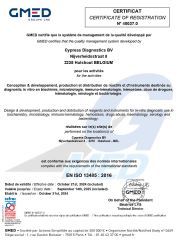Chlamydia Ag
-
Method:
Immunochromatographic
-
Package:
20 t
-
Product code:
322
-
CE:
-
-
Storage temperature:
4 - 30 °C
-
Clinical significance:
Chlamydiae are a large group of obligate intracellular parasites which are closely related to gram negative bacteria. They are assigned to three species C. trachomatis, C. psittaci and C. pneumoniae. The developmental cycle of Chlamydia involves two morphologically distinct particles, i.e. an infectious type – the elementary body and reproductive type - the reticulate body1. These pathogens affect millions of individuals throughout the world. The human Chlamydial infections include trachoma-inclusion conjunctivitis (TRIC), lymphogranuloma venerum (LGV) and an ever increasing number of sexually transmitted infections (at least 25 clinical syndromes) which were previously thought to be due to other agents or to be of unknown etiologies (proctitis, cervicitis, infertility, Reiter’s Syndrome, epididymitis, pelvic inflammatory disease and ectopic pregnancy). Various evidences suggest that Chlamydiae are responsible for at least 40 % of the cases of non-gonococcal urethritis in males2-5. The majority of Chlamydial infections in females are asymptomatic with carrier rates of over 20 %. Subclinical infections appear to be the major cause of sterility in women. Since Chlamydiae infections do not respond to penicillin, used for treatment of Neisseria gonorrhea, about 60% of the patients having gonorrhea develop postgonococcal urethritis when concurrently infected with Chlamydia5. Furthermore, Chlamydial infections are a serious health threat to newborns who contract occular infections at birth from infected birth canals of their mothers and almost 50 % of these children develop inclusion conjunctivitis and 20 % develop systemic infection resulting in serious pneumonia3. It has been reported that C. trachomatis confers an increased risk for the development of invasive cervical cancer6. C. psittaci, which is mainly an animal pathogen, is known to cause psittacosis in humans. C. pneumoniae accounts for about 10-20 % of all radiographically documented pneumoniae in adults. C. trachomatis is subdivided into 15 serovars (immunotypes). Serovars L1, L2 and L3 have been isolated mainly from patients with LGV and the remaining 12 serovars have been recovered with other Chlamydia associated clinical syndromes2. Since Chlamydial infections are increasing in incidence, their accurate and rapid diagnosis in clinical laboratories is essential for successful therapy6,7. Various methods are available for the diagnosis of Chlamydia infections. The traditional method is inoculation of monolayer cell culture with clinical samples, followed by staining and visual examination after 2-3 days. However, the tissue culture methodology is difficult, lengthy, expensive and not widely available in most clinical settings. The routine serologic diagnosis of Chlamydial infections requires the measurement of antichlamydial antibody titer changes in the paired sera (four-fold greater rise in titer) and has a low predictive value for ongoing infection. Direct tests such as ELISA and IF (immunofluorescence) are regarded as easier to perform and require less time and labor than culturing of the organism. However, IF requires specialized equipment and a skilled operator. It can therefore, limit the number of samples that can be routinely screened in a day8,9. Cypress Diagnostics provides the lab with a simple and easy to use gold-particle based immunoassay for the detection of Chlamydia antigen. This test requires no other equipment, making it ideally suited for point of care testing.
-
Intended use:
The Cypress Diagnostics Chlamydia Test is intended for in vitro diagnostic use in the rapid, qualitative detection of Chlamydia trachomatis directly from female endocervical swab and male/female urethral swab. The test is intended for use as an aid in the diagnosis of Chlamydia infections.




